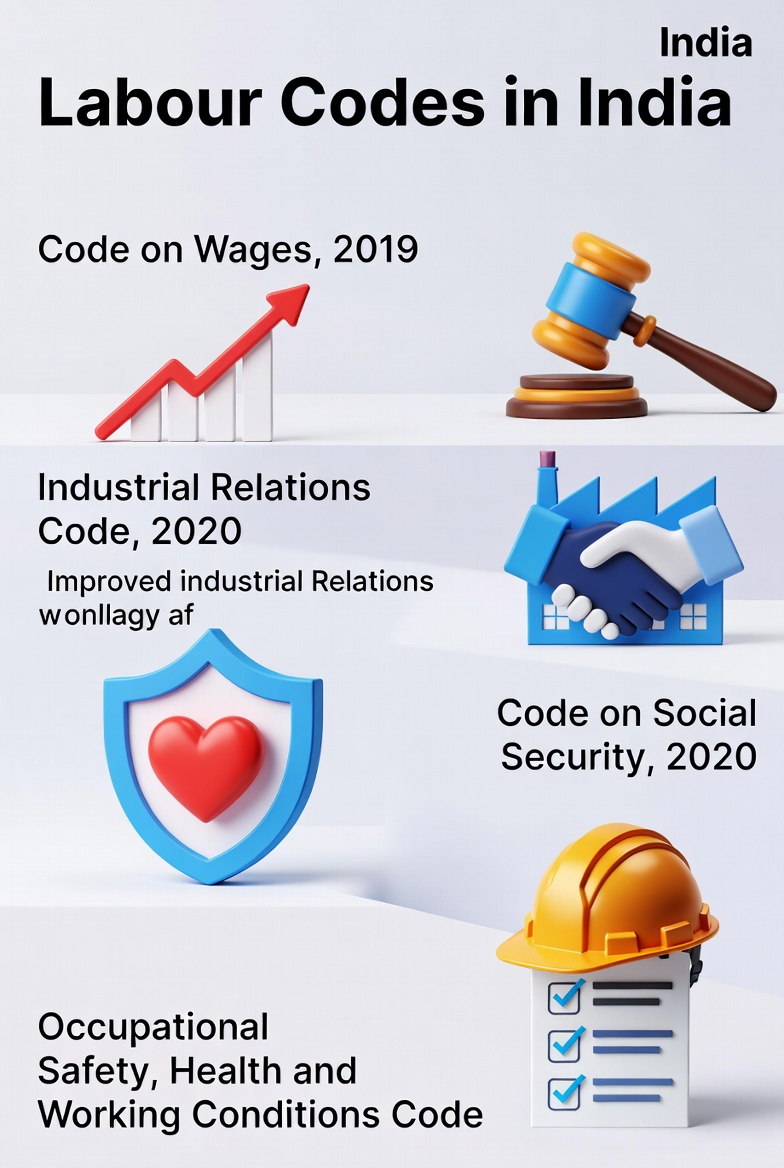In a move that’s being hailed as one of the most transformative reforms since Independence, the Indian government has finally flipped the switch on four consolidated Labour Codes, effectively streamlining 29 outdated laws into a more agile, worker-friendly framework.
—effective immediately from today—
marks the end of decades of fragmented regulations that hark back to the colonial era and early post-Independence years. It’s not just paperwork; it’s a bold step toward building an “Aatmanirbhar” workforce ready for the gig economy, AI-driven industries, and everything in between.
The Backstory: From Colonial Relics to Modern Mandates
Let’s rewind a bit. India’s labour laws, many penned in the 1930s and 1950s, were designed for a world of rigid factories and predictable jobs—think steam engines, not smartphones. 2 Fast-forward to 2025, and we’ve got a workforce that’s 90% informal, teeming with migrants, gig workers, and remote freelancers. The old system? A compliance nightmare for businesses and a protection gap for employees. Enter the four Labour Codes, passed by Parliament between 2019 and 2020 but delayed by the pandemic and stakeholder consultations. Today, Labour Minister Mansukh Mandaviya declared them “the law of the land,” signaling that the wait is over.
These codes aren’t reinventing the wheel—they’re consolidating it. By merging 29 central laws, they cut red tape while expanding safeguards. The transition period allows old rules to linger where needed, giving everyone breathing room to adapt.
Breaking Down the Big Four: What Each Code Brings to the Table
Here’s a quick rundown of the star players, straight from the government’s playbook:
- Code on Wages, 2019: This one’s all about fair pay. It mandates timely wages, minimum wage floors, and—crucially—equal pay for equal work, regardless of gender. No more “pink collar” discounts. It also simplifies bonus structures, making payouts more transparent and less prone to disputes.
- Industrial Relations Code, 2020: Aiming to ease tensions between workers and management, this code streamlines trade union recognition, dispute resolution, and layoffs. It raises the threshold for strikes and lockouts, promoting dialogue over disruption, while protecting workers’ rights to organize.
- Code on Social Security, 2020: The game-changer for the unorganized sector. It extends benefits like maternity leave, disability support, and pensions to gig and platform workers—think Uber drivers or Zomato delivery folks. Portability is key here: benefits travel with you across jobs and states, a boon for India’s 500 million-plus informal labourers.
- Occupational Safety, Health and Working Conditions (OSHWC) Code, 2020: Safety first, always. This expands coverage to all sectors, including night shifts for women (with safeguards like transport and creches). It mandates health check-ups, hazard controls, and working hour limits, closing loopholes in small factories and high-risk industries.
Collectively, they rationalize everything from factories acts to contract labour rules, creating a unified ecosystem that’s easier to navigate for employers and more empowering for employees.
Wins for Workers, Boost for Businesses: The Double-Edged Promise
From a worker’s lens, this is a win. Expanded ESIC (Employees’ State Insurance Corporation) coverage now includes smaller setups and hazardous gigs, ditching the old geographic and size-based exclusions.
5 Night shifts for women?
That’s progressive gold, opening doors in IT, hospitality, and beyond. And equal pay? It’s not just rhetoric—it’s enforceable law, potentially narrowing India’s stubborn gender wage gap.
For businesses, especially SMEs buried under compliance costs, this is relief. Fewer laws mean less paperwork, faster hiring/firing with checks, and a clearer path to scalability. The gig economy gets a formal nod, which could attract more investment into platforms like Swiggy or Ola. As the ministry puts it, this aligns India with global peers who’ve long modernized their labour regimes.
7. But let’s not pop the champagne yet. Critics (though muted in today’s announcements) worry about diluted protections—like easier layoffs potentially fueling precarious jobs.
Implementation will be the real test: Will states align quickly? Will enforcement bodies get the funding? The Rediff piece hints at optimism, framing it as a “foundation for resilient industries,” but real impact hinges on rules notification and awareness drives.
Looking Ahead: A Workforce for the AI Age?
This isn’t just about today—it’s about tomorrow. With India eyeing a $5 trillion economy, these codes position us as a labour market that’s flexible yet fair, attracting FDI while uplifting the bottom billion. Imagine migrant workers seamlessly accessing EPFO across borders or AI ethicists debating safety in virtual offices. The potential is electric.
As we toast this historic Friday, one thing’s clear: India’s labour story is evolving from survival to thriving.
Kudos to the government for pulling the trigger—what’s your take? Will this spark a job boom, or do we need more tweaks? Drop your thoughts below.
References: Primarily drawing from Rediff’s coverage and cross-verified with Economic Times, Deccan Chronicle, and The Tribune for a rounded view.
@Parshar from NewzQuest
Discover more from Newz Quest
Subscribe to get the latest posts sent to your email.

